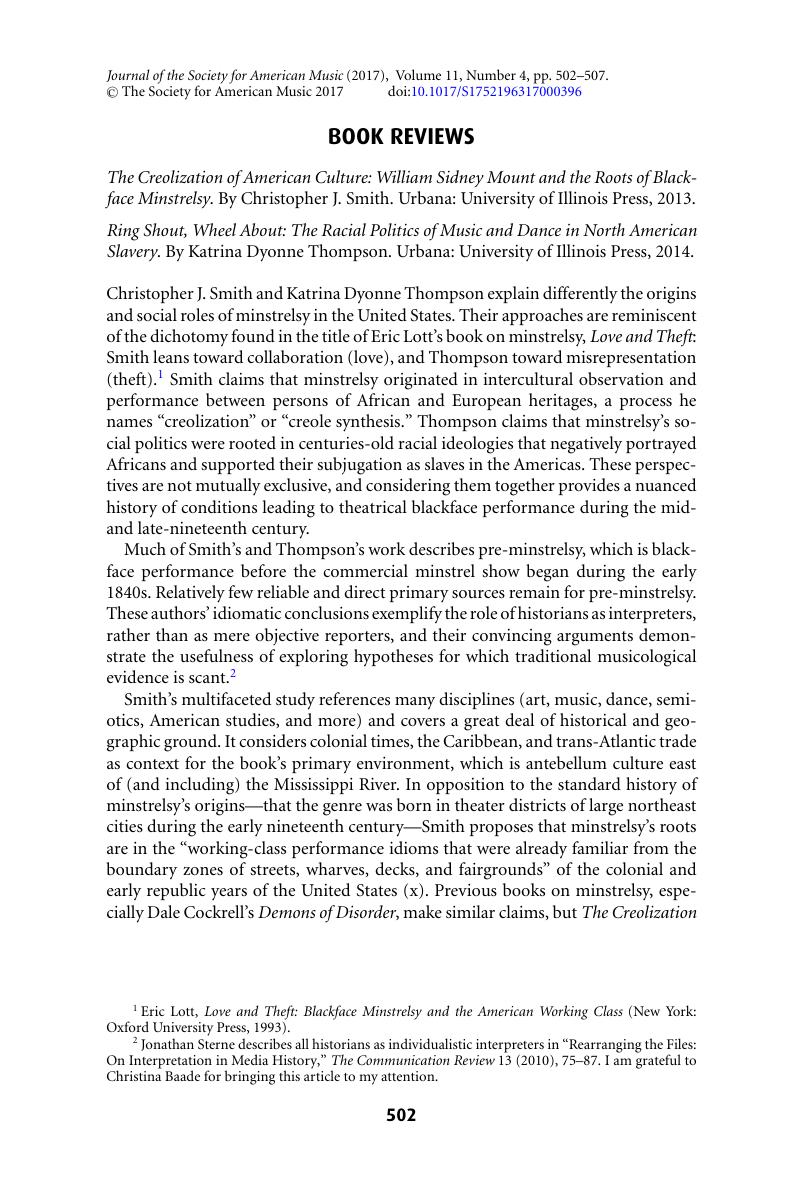No CrossRef data available.
Article contents
The Creolization of American Culture: William Sidney Mount and the Roots of Blackface Minstrelsy. By Christopher J. Smith . Urbana: University of Illinois Press, 2013. - Ring Shout, Wheel About: The Racial Politics of Music and Dance in North American Slavery. By Katrina Dyonne Thompson . Urbana: University of Illinois Press, 2014.
Published online by Cambridge University Press: 20 October 2017
Abstract

- Type
- Book Review
- Information
- Copyright
- Copyright © The Society for American Music 2017
References
1 Lott, Eric, Love and Theft: Blackface Minstrelsy and the American Working Class (New York: Oxford University Press, 1993)Google Scholar.
2 Jonathan Sterne describes all historians as individualistic interpreters in “Rearranging the Files: On Interpretation in Media History,” The Communication Review 13 (2010), 75–87 CrossRefGoogle Scholar. I am grateful to Christina Baade for bringing this article to my attention.
3 Cockrell, Dale, Demons of Disorder: Early Blackface Minstrels and Their World (Cambridge: Cambridge University Press, 1997)Google Scholar; see also Carlin, Bob, The Birth of the Banjo: Joel Walker Sweeney and Early Minstrelsy (New York: McFarland, 2007)Google Scholar.
4 In the next chapter, Smith defines “polyrhythm” more usefully as the “simultaneous execution of several time signatures” (178).
5 Nathan, Hans, Dan Emmett and the Rise of Early Minstrelsy (Norman: University of Oklahoma Press, 1962, 1977)Google Scholar; Parrish, Lydia, Slave Songs of the Georgia Sea Islands (Athens: University of Georgia, 1992)Google Scholar.
6 Dale Cockrell, prologue to Demons of Disorder.
7 This argument was made previously by Bob Carlin in The Birth of the Banjo.
8 Miller, Karl Hagstrom, “Revisiting Minstrelsy: Love & Theft at Twenty,” American Music 33, no. 2 (2015): 277 CrossRefGoogle Scholar.
9 Toll, Robert C., Blacking Up: The Minstrel Show in Nineteenth-Century America (New York: Oxford University Press, 1974)Google Scholar; Dennison, Sam, Scandalize My Name: Black Imagery in American Popular Music (New York: Garland, 1982)Google Scholar; Leonard, William Torbert, Masquerade in Black (Metuchen, NJ: Scarecrow, 1986)Google Scholar.
10 Lott, Love and Theft, 140–41.
11 See, for example, the image of an 1854 playbill for a Christy's Minstrels show captioned as 1857 (175), and the endnotes for chapter 6, where, among a few other inconsistencies, Leonard's Masquerade in Black is cited several times in short format before the full citation is provided.




